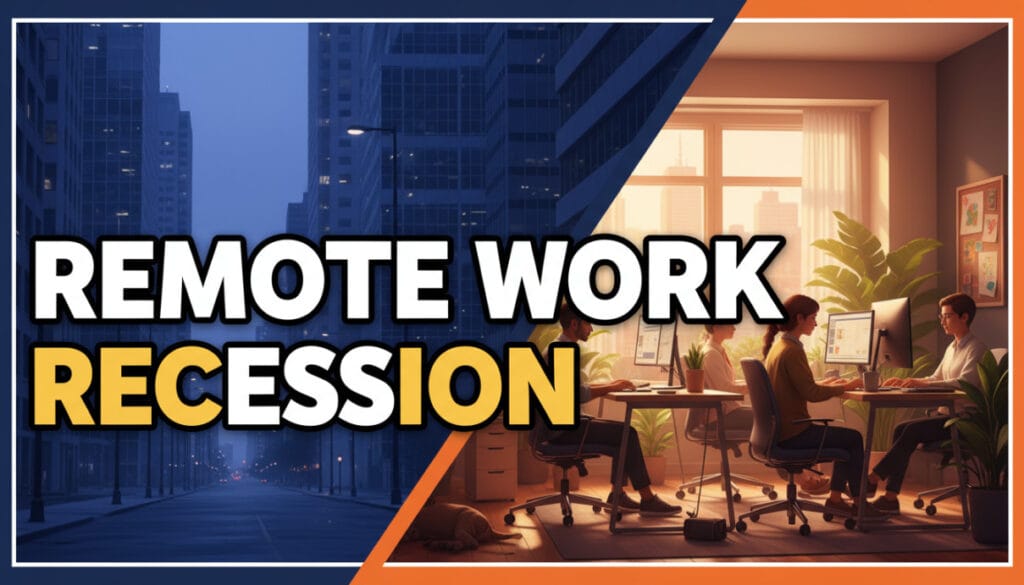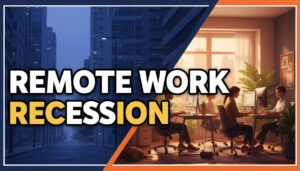The Great Remote Work Recession: How America’s Return-to-Office Push is Quietly Reshaping the Economy

A seismic shift in workplace dynamics is creating unexpected economic ripple effects, from commercial real estate crashes to suburban spending booms — and the full impact is just beginning to unfold.
Three years after the pandemic transformed how America works, a quiet economic revolution is unfolding in office buildings, coffee shops, and suburban neighborhoods across the nation. While headlines focus on inflation and interest rates, a more fundamental shift is reshaping entire sectors of the economy: the ongoing battle between remote work and return-to-office mandates.
What began as a temporary health measure has evolved into the most significant workplace transformation since the Industrial Revolution — and its economic implications are far more complex and far-reaching than most policymakers and business leaders anticipated.
The Numbers Tell a Stark Story
Recent data reveals the scope of this transformation. According to the Bureau of Labor Statistics, approximately 35% of the U.S. workforce now works remotely at least part-time, compared to just 7% before 2020. But the economic impact extends far beyond employment statistics.
Commercial real estate values in major metropolitan areas have plummeted by an average of 25-40% since 2020, with some downtown districts seeing vacancy rates exceed 30%. Meanwhile, residential markets in suburban and rural areas have experienced unprecedented growth, with home prices in previously affordable regions rising by 20-50% over the past three years.
This isn’t just about where people work — it’s about where money flows, where businesses thrive, and where entire economic ecosystems are being rebuilt from the ground up.
The Urban Economic Exodus
Downtown Devastation
The economic devastation in urban cores is becoming impossible to ignore. Cities like San Francisco, Seattle, and New York have seen their commercial tax bases erode as major corporations reduce their office footprints or abandon downtown locations entirely.
San Francisco’s downtown office occupancy rates hover around 50% of pre-pandemic levels, according to recent city data. This translates directly into reduced tax revenue — the city faces a projected $728 million budget deficit over the next two years, largely attributed to declining commercial property values and reduced business activity.
The ripple effects cascade through urban economies. Restaurants, dry cleaners, parking garages, and countless service businesses that depended on office workers are closing or dramatically downsizing. A recent study by the Federal Reserve Bank of San Francisco found that every remote worker represents approximately $4,600 in lost annual spending in their former office neighborhood.
The Retail Apocalypse Accelerates
Urban retail, already struggling before the pandemic, faces an existential crisis. The International Council of Shopping Centers reports that foot traffic in downtown shopping districts remains 25-35% below 2019 levels in most major cities. High-end retailers are abandoning premium downtown locations, while small businesses struggle to survive on reduced customer bases.
This creates a vicious cycle: fewer businesses mean fewer reasons for people to visit downtown areas, which further reduces foot traffic and economic activity.
The Suburban Economic Boom
New Centers of Commerce
While urban cores struggle, suburban and rural communities are experiencing an economic renaissance. Small towns and suburban areas are seeing unprecedented growth in local businesses, from co-working spaces to specialized service providers catering to remote workers.
Boise, Idaho, exemplifies this transformation. The city has seen a 40% increase in new business registrations since 2020, driven largely by remote workers relocating from expensive coastal cities. Local restaurants, fitness centers, and professional services are thriving as former urban professionals bring their spending power to previously overlooked markets.
The Infrastructure Challenge
However, this suburban boom isn’t without complications. Many smaller communities lack the infrastructure to support sudden population and economic growth. Internet connectivity, healthcare facilities, and transportation systems are struggling to keep pace with demand.
The economic implications are significant: communities must invest heavily in infrastructure upgrades, often straining local budgets and requiring new financing mechanisms. Some economists argue this represents a necessary rebalancing of economic development, while others worry about the sustainability of rapid growth in unprepared markets.
Corporate America’s Trillion-Dollar Dilemma
The Real Estate Reckoning
Corporations face an unprecedented challenge with their real estate portfolios. Many companies signed long-term leases worth billions of dollars for office spaces that now sit largely empty. Breaking these leases or renegotiating terms represents massive financial losses, while maintaining unused space drains resources that could be invested in growth.
Tech giants like Meta and Google have already written off billions in real estate costs, while financial services firms grapple with expensive Manhattan office spaces that house a fraction of their pre-pandemic workforce.
Productivity vs. Culture
The economic debate extends beyond real estate to fundamental questions about productivity and innovation. While numerous studies suggest remote workers are often more productive on individual tasks, concerns about collaboration, mentorship, and company culture are driving many firms to mandate returns to office.
This creates a complex economic calculation: potential productivity gains from remote work versus the costs of maintaining office infrastructure and the intangible benefits of in-person collaboration.
Policy Implications and Government Response
Tax Base Erosion
Local and state governments face a fiscal crisis as commercial property values decline and high-earning residents relocate to lower-tax jurisdictions. New York State, for instance, has seen a significant exodus of high-income taxpayers, reducing income tax revenue at a time when the state needs resources to address urban challenges.
This tax base erosion forces difficult choices: raise taxes on remaining residents and businesses (potentially accelerating the exodus) or cut services and infrastructure investment (potentially making cities less attractive for future growth).
Federal Considerations
At the federal level, policymakers are beginning to grapple with the implications of this economic shift. Some propose tax incentives to encourage urban office occupancy, while others advocate for policies that support the distributed workforce model.
The Federal Reserve has noted that geographic redistribution of economic activity could affect monetary policy transmission, as different regions respond differently to interest rate changes.
The Innovation Economy Paradox
Perhaps most intriguingly, the remote work revolution is creating unexpected innovation hubs. Cities like Austin, Nashville, and Miami are attracting tech talent and startup activity previously concentrated in Silicon Valley and New York.
This geographic diversification of innovation could prove economically beneficial in the long term, reducing the concentration risk that made certain regions overly dependent on specific industries. However, it also challenges the cluster effects that have historically driven innovation and economic growth in tech centers.
Looking Ahead: Economic Transformation or Temporary Disruption?
The fundamental question facing economists, policymakers, and business leaders is whether the current shift represents a permanent economic transformation or a temporary disruption that will eventually revert to pre-pandemic patterns.
Early indicators suggest the changes may be more permanent than initially anticipated. Generation Z workers, who entered the workforce during the pandemic, show strong preferences for remote or hybrid work arrangements. Companies that have successfully adapted to distributed workforces are seeing competitive advantages in talent acquisition and retention.
However, the economic pressures on urban cores and the infrastructure challenges in growing suburban areas suggest that the current trajectory is unsustainable without significant policy interventions and private sector adaptations.
Key Takeaways: Navigating the New Economic Landscape
The remote work revolution represents more than a workplace trend — it’s a fundamental restructuring of how and where economic value is created and captured in America. The winners and losers in this transformation will be determined by how quickly they adapt to new realities.
For businesses, success will require rethinking real estate strategies, compensation models, and operational structures. For communities, it means investing in infrastructure and services that attract and retain remote workers. For policymakers, it demands new approaches to taxation, regulation, and economic development that account for a more distributed economic landscape.
The economic implications of this shift will continue to unfold over the coming years, reshaping everything from real estate markets to retail patterns to innovation ecosystems. Those who recognize and adapt to these changes early will be best positioned to thrive in the new economy.
Stay Informed: Join the Economic Evolution
As this economic transformation continues to unfold, staying informed about its implications is crucial for investors, business leaders, and policymakers alike. The decisions made today about remote work policies, urban development, and economic strategy will shape America’s economic landscape for decades to come.
Share this analysis with your network and join the conversation about how we can navigate this unprecedented economic shift while building a more resilient and equitable economy for all Americans.







